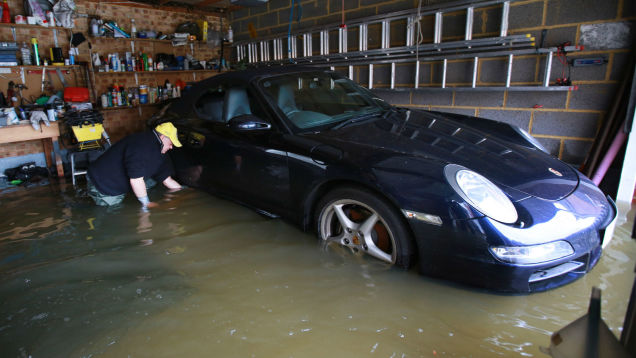Avoid Buying Flood Damaged Cars…Trouble
Avoid Getting Soaked by a Flood-Damaged Vehicle
By Hiram Reisner
The violent storms that have inundated the country’s heartland this spring and summer have caused considerable damage to homes, businesses and infrastructure — and some deaths. Casualties also include many cars and trucks, which pose a threat to unsuspecting buyers down the road when, inevitably, a share of them re-enter the market with cosmetic fixes covering the damage.
Approximately 10,000 vehicles were seriously damaged or totaled in Texas flooding alone, according to industry experts, NBC News reports.
“A car that’s been in a flood, with the engine [immersed] for any length of time, will never be the same,” says Carl Sullivan, a veteran inspector for California-based Alliance Inspection Management, the report said.
If you learn the signs of flood damage — some are obvious and some are not at all — you can avoid being suckered into buying a vehicle that appears fine but is actually at the end of the road.
In a warning to consumers after one of this year’s floods, the National Insurance Crime Bureau, which works with law enforcement agencies, insurance and car rental companies to assess damage, issued this word of warning in a release:
“Unfortunately, natural disasters bring out dishonest salvage dealers who don’t tell you that the vehicles they’re selling are heavily water-damaged,” said NICB President and CEO Joe Wehrle.
“Consumers need to know that these vehicles may appear advertised for sale without any indication that they were affected by the flooding. As always, buyers should be careful when considering a used vehicle purchase in the weeks and months following a disaster like this.”
To avoid purchasing a flood-damaged vehicle, the first thing you should do is have it examined by a trusted mechanic. (For tips on that, check out 13 Steps to Finding an Honest Auto Mechanic.)
The next step is to order a VIN (vehicle identification number) check, according to DMV.org, a privately owned website not affiliated with any government entity.
Flood-damaged vehicles are supposed to be reported. If the vehicle you want is deemed flood-damaged, it should appear when you order a Vehicle History Report, also known as a VIN check or VIN report.
Another step is to check the status of the title, according to the Federal Trade Commission.
A “salvage title” means the car was declared a total loss by an insurance company because of a serious accident or some other problems. A “flood title” means the car has damage from sitting in water deep enough to fill the engine compartment. The title status is part of a vehicle history report.
There are also visible warning signs that could indicate the vehicle has been in a flood, says DMV.org, including:
- New upholstery in a used vehicle that doesn’t match the carpeting.
- Rust in places like door hinges and trunk latches.
- Rust under the gas and brake pedals.
- Silt or mud under the seats or in the glove compartment.
- Wet floor carpeting.
- A musty or moldy smell inside the vehicle.
- Brittle wires underneath the dashboard, which could mean they have been wet and then dried out. Reach down there to make sure the wires are pliable.
- Malfunctioning electronics or accessories. Turn on the ignition and make sure all dashboard warning and accessories work properly. Test the air conditioning, heater, windshield wipers, radio and turn signals several times.
- VIN inconsistencies. Make sure the VIN on the dashboard matches the VIN on the doorjamb.
Finally, if you see something fishy, say something.
“If a dealer fraudulently tries to sell you a flood-damaged car, they’re breaking the law: report them,” says Money Talks News founder Stacy Johnson.
If you suspect a dealer is knowingly selling a storm-damaged car or a salvaged vehicle as a good-condition used car, contact your auto insurance company, local law enforcement agency, or the NICB at 800-835-6422. You’ll help someone else avoid a rip-off.
More from Money Talks News







